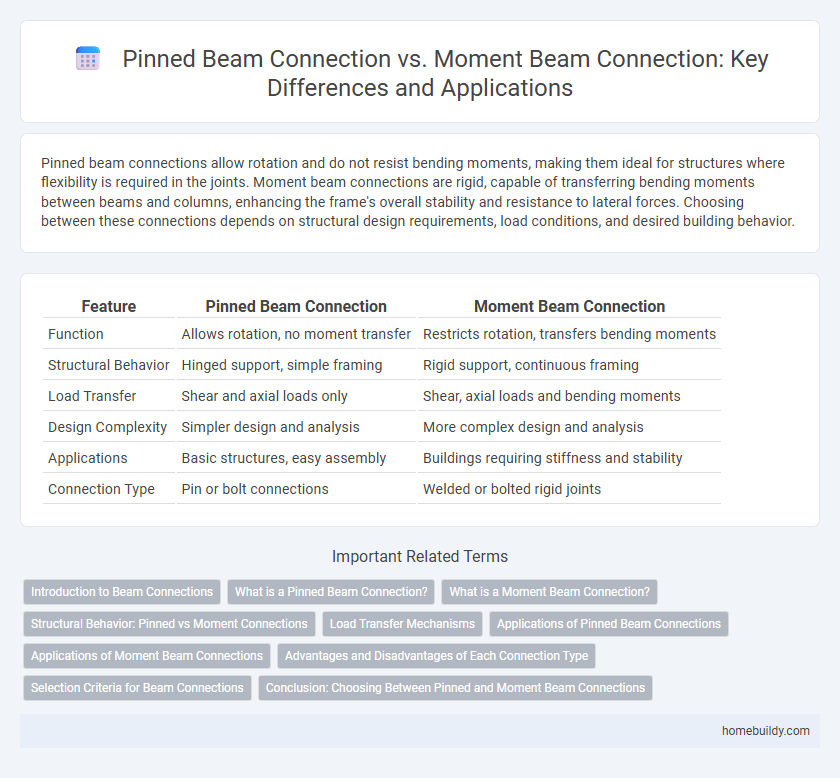Pinned beam connections allow rotation and do not resist bending moments, making them ideal for structures where flexibility is required in the joints. Moment beam connections are rigid, capable of transferring bending moments between beams and columns, enhancing the frame's overall stability and resistance to lateral forces. Choosing between these connections depends on structural design requirements, load conditions, and desired building behavior.
Table of Comparison
| Feature | Pinned Beam Connection | Moment Beam Connection |
|---|---|---|
| Function | Allows rotation, no moment transfer | Restricts rotation, transfers bending moments |
| Structural Behavior | Hinged support, simple framing | Rigid support, continuous framing |
| Load Transfer | Shear and axial loads only | Shear, axial loads and bending moments |
| Design Complexity | Simpler design and analysis | More complex design and analysis |
| Applications | Basic structures, easy assembly | Buildings requiring stiffness and stability |
| Connection Type | Pin or bolt connections | Welded or bolted rigid joints |
Introduction to Beam Connections
Pinned beam connections allow rotation between connected members, providing structural flexibility by transferring shear forces without resisting moments. Moment beam connections create rigid joints that resist bending through moment transfer, ensuring greater stiffness and stability in frames. Understanding these fundamental differences is crucial for designing safe and efficient structural systems.
What is a Pinned Beam Connection?
A pinned beam connection is a structural joint designed to allow rotation without resisting bending moments, effectively transferring shear and axial forces while accommodating angular displacement. This connection typically uses bolts, rivets, or pins, enabling beams to pivot relative to columns or other supports, ensuring flexibility under load. Pinned beam connections are commonly applied in frameworks where rotational movement is necessary to prevent stress buildup and maintain structural integrity.
What is a Moment Beam Connection?
A Moment Beam Connection is a structural joint designed to resist bending moments by rigidly connecting beams to columns or other beams, allowing the transfer of both shear forces and moments. This type of connection ensures structural stability and continuity, preventing rotation at the joint and enabling the frame to act as a single, unified element under load. Moment connections are critical in steel and concrete frame construction where enhanced rigidity and load distribution are required for seismic resistance and overall building performance.
Structural Behavior: Pinned vs Moment Connections
Pinned beam connections allow rotation and do not resist moments, resulting in zero moment transfer and relying solely on shear forces for load transfer, which permits flexibility and reduces internal stresses in the beam. Moment beam connections resist rotation by transferring bending moments through rigid joints, creating a fixed connection that enhances structural rigidity and distributes loads more evenly between beams and columns. The choice between pinned and moment connections significantly impacts frame behavior, where moment connections enable moment redistribution and increased stability, while pinned connections accommodate frame movement and minimize moment demands on supporting members.
Load Transfer Mechanisms
Pinned beam connections transfer loads primarily through shear forces, allowing rotation at the joint with minimal moment resistance, making them suitable for structures where flexibility and unrestrained rotational movement are necessary. Moment beam connections resist bending moments by rigidly connecting beams and columns, facilitating the transfer of both shear forces and moments to maintain structural stability under lateral loads. This rigidity in moment connections enhances the frame's overall stiffness, distributing loads more evenly and reducing deflections compared to pinned connections.
Applications of Pinned Beam Connections
Pinned beam connections are commonly used in structures where rotation is permitted but moment resistance is not required, such as bridges, roof trusses, and steel frames. These connections facilitate efficient load transfer through shear forces while allowing beam movement under loads, minimizing stress concentrations. Their application is ideal in buildings subject to thermal expansion or seismic activity where flexibility is essential.
Applications of Moment Beam Connections
Moment beam connections are primarily used in structures requiring high rigidity and resistance to bending, such as multi-story buildings and seismic zones. These connections enable beams to transfer bending moments to columns, providing enhanced structural stability and reducing lateral displacement. Common applications include steel frame construction, bridges, and areas subjected to dynamic loads where stability and strength are critical.
Advantages and Disadvantages of Each Connection Type
Pinned beam connections allow rotational movement between the beam and column, reducing moment transfer and simplifying structural analysis, but they provide less rigidity and can lead to larger deflections under load. Moment beam connections rigidly connect the beam to the column, offering greater structural stiffness and better resistance to lateral forces, but they require more complex design and fabrication, increasing costs. Choosing between pinned and moment connections depends on factors such as load requirements, desired flexibility, and overall design complexity.
Selection Criteria for Beam Connections
Selection criteria for beam connections primarily depend on load types, structural requirements, and construction feasibility. Pinned beam connections are optimal when allowing rotational movement and reducing bending moments at the joint, best suited for simple support conditions under axial or shear loads. Moment beam connections, selected for their rigidity, resist rotation and transfer bending moments, ideal in frames requiring structural continuity and enhanced stiffness.
Conclusion: Choosing Between Pinned and Moment Beam Connections
Pinned beam connections provide rotational flexibility and are ideal for structures requiring simpler load transfer with minimal moment resistance, typically suited for lightly loaded frames. Moment beam connections offer rigid joint behavior, effectively resisting bending moments and providing enhanced structural stability in heavily loaded or seismic-prone environments. Selecting between pinned and moment connections depends on load conditions, structural design requirements, and desired flexibility, with moment connections favored for high stiffness and pinned for allowing controlled rotations.
Pinned beam connection vs Moment beam connection Infographic

 homebuildy.com
homebuildy.com